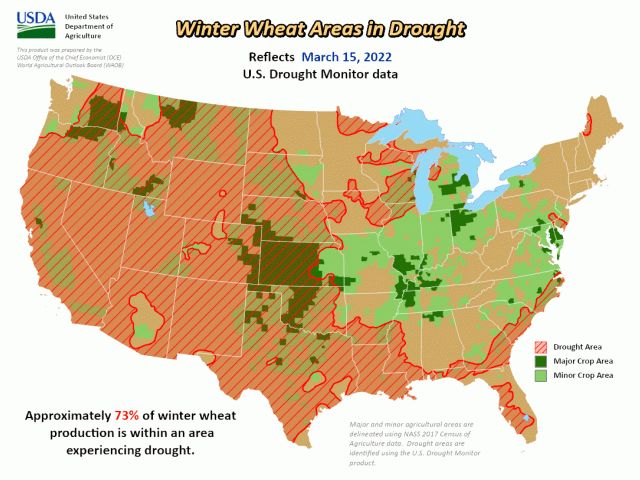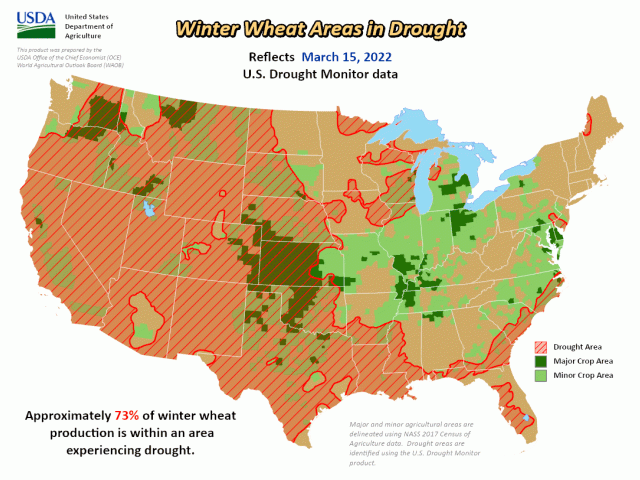Ag Weather Forum
Early Spring Drought Review for US Grain and Oilseed Crops
A look at drought assessments for primary U.S. grain and oilseed crops going into spring this year show, again, the impact of the sharp divide between west and east when it comes to precipitation. Row crops are in relatively good shape because of heavier amounts -- which, in some areas, leads to concern about wet soils; while small grains for the most part have a notable dryness hurdle to overcome.
Using information from the Drought Monitor, USDA's weekly Ag in Drought report shows these percentages of cropland in drought, as of March 15, along with a comparison with conditions a year ago at the same time.
The mid-March drought assessments are large for some important small grains. For winter wheat, drought is judged to be in effect across 73% -- almost three-quarters -- of U.S. winter wheat areas. That is almost three times the 26% drought coverage in mid-March a year ago and occurs at a time when the world wheat market is in turmoil due to supply dislocation caused by Russia's invasion of Ukraine. (A side note: there is not a distinction made between winter wheat varieties in this assessment.)
P[L1] D[0x0] M[300x250] OOP[F] ADUNIT[] T[]
Other crops with a western U.S. concentration have similar or greater drought coverage. Durum wheat acreage has had some drought easing from a year ago but is still 80% in drought; the drought coverage a year ago was 90%. Drought easing in North Dakota is the reason for durum drought improvement. Sunflower acreage is also still well into drought at 72%, but the extent of drought effect is down notably from 94% a year ago due again to drought easing in North Dakota. And grain sorghum acreage, with a dominant presence in the Southern Plains, is listed at 92% drought-affected in mid-March 2022, more than twice the 44% drought coverage posted last year.
At the lower end of the drought impact spectrum, corn and soybeans get along reasonably well. For corn, just over one-third -- 36% -- of corn areas are judged to be in drought. That area is larger than a year ago when 21% of U.S. corn areas were noted in drought.
For soybeans, conditions are even better with 26% of U.S. soybean areas judged to be in drought -- again, slightly more than the 19% noted in mid-March 2021. Also, spring wheat acreage in drought is far less than last year at 41% compared with 78% in mid-March 2021.
Rain and snow during the past week likely brought some easing of dry conditions in the Plains and western Midwest. Still, the extent of drought coverage going into a time of high moisture demand as crops are either seeded or exiting winter dormancy makes the forecast of continued drought during almost the entire western half of the lower 48 states a logical conclusion for the balance of this spring season.
Bryce Anderson can be reached at Bryce.anderson@dtn.com
Follow him on Twitter @BAndersonDTN
(c) Copyright 2022 DTN, LLC. All rights reserved.






Comments
To comment, please Log In or Join our Community .